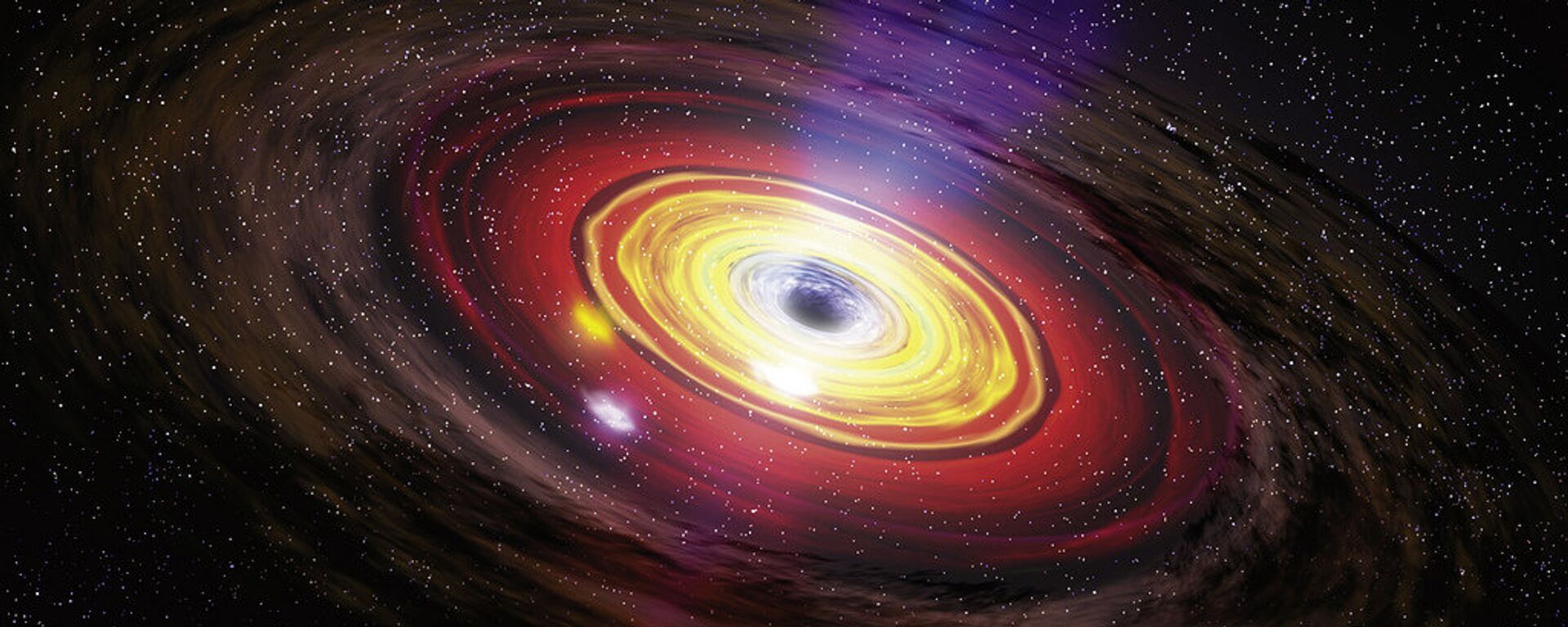https://sputnikglobe.com/20231106/astronomers-discover-oldest-black-hole-yet--1114774514.html
Astronomers Discover Oldest Black Hole Yet
Astronomers Discover Oldest Black Hole Yet
Sputnik International
The blackhole itself, they deduced, was formed just 470 million years after the big bang---making it the oldest blackhole to be discovered yet.
2023-11-06T23:58+0000
2023-11-06T23:58+0000
2023-11-06T23:57+0000
beyond politics
space
space exploration
science & tech
nasa
black hole
supermassive black hole
https://cdn1.img.sputnikglobe.com/img/07e7/0b/06/1114774182_0:104:2000:1229_1920x0_80_0_0_dc5cbcec17c4f3e1b9ccf22689a5c0ea.jpg
Using data from NASA’s Chandra X-ray Observatory and NASA’s James Webb Space Telescope, a team of researchers have discovered a growing black hole that is inside a galaxy located 13.2 billion light-years from Earth. The blackhole, researchers deduced, was formed just 470 million years after the big bang, making it the oldest black hole to be discovered yet. “We needed Webb to find this remarkably distant galaxy and Chandra to find its supermassive black hole,” said Akos Bogdan from the Harvard-Smithsonian Center for Astrophysics, who led the paper. “We also took advantage of a cosmic magnifying glass that boosted the amount of light we detected.”The galaxy that Bogdan and his team found is named UHZ1 and is in the direction of the galaxy cluster Abell 2744. After discovering the galaxy, two weeks of observations with Chandra revealed an intense X-ray emitting gas in the galaxy: a clear sign of a growing supermassive black hole.The black hole, which is estimated to be 10 to 100 million times more massive than our sun, may help astronomers understand how black holes can reach colossal masses in such a short amount of time. Bogdan and his team have found evidence that the black hole was, indeed, born massive. Its mass is similar to that of all the stars in its galaxy where it resides, which is very different from other, nearby black holes that typically contain just 1/10th of a percent of the mass of their galaxy’s stars.Most likely, the black hole was formed from the collapse of a huge cloud of gas. The phenomenon is referred to as an ‘Outside Black Hole,’ and this particular black hole may be the first detection of such a phenomenon. Either way, the discovery is not only a first in terms of learning more about black holes - it will also help researchers paint a wider, and more detailed picture of what the universe first looked like following its creation.“This is one of the most dramatic discoveries to come out of the James Webb Space Telescope” and the discovery of the most distant growing supermassive black hole known, saidMichael Strauss, a professor and chair of astrophysical sciences at Princeton, who discussed the findings with the researchers but was not part of the research team, has said that the new find is "one of the most dramatic discoveries to come out of the James Webb Space Telescope."The team's findings were published in the journal Nature Astronomy.
https://sputnikglobe.com/20231028/monster-duo-of-black-holes-closest-to-earth-result-of-galactic-collision-study-shows-1114546997.html
Sputnik International
feedback@sputniknews.com
+74956456601
MIA „Rosiya Segodnya“
2023
Mary Manley
https://cdn1.img.sputnikglobe.com/img/07e6/01/0b/1092187887_0:0:2048:2049_100x100_80_0_0_0c2cc4c84f89aff034cc55bb01fb6697.jpg
Mary Manley
https://cdn1.img.sputnikglobe.com/img/07e6/01/0b/1092187887_0:0:2048:2049_100x100_80_0_0_0c2cc4c84f89aff034cc55bb01fb6697.jpg
News
en_EN
Sputnik International
feedback@sputniknews.com
+74956456601
MIA „Rosiya Segodnya“
Sputnik International
feedback@sputniknews.com
+74956456601
MIA „Rosiya Segodnya“
Mary Manley
https://cdn1.img.sputnikglobe.com/img/07e6/01/0b/1092187887_0:0:2048:2049_100x100_80_0_0_0c2cc4c84f89aff034cc55bb01fb6697.jpg
science, nasa, blackhole, supermassive blackhole, nasa's chandra, nasa’s james webb space telescope, galaxy, space, space exploration
science, nasa, blackhole, supermassive blackhole, nasa's chandra, nasa’s james webb space telescope, galaxy, space, space exploration
Astronomers Discover Oldest Black Hole Yet
One aspect of the black hole has never been seen before: it is at a growth stage that is so early, its mass is similar to its host galaxy.
Using data from NASA’s Chandra X-ray Observatory and NASA’s James Webb Space Telescope, a team of researchers have discovered a growing black hole that is inside a galaxy located 13.2 billion light-years from Earth.
The blackhole, researchers deduced, was formed just 470 million years after the big bang, making it the oldest black hole to be discovered yet.
“We needed Webb to find this remarkably distant galaxy and Chandra to find its supermassive black hole,” said
Akos Bogdan from the Harvard-Smithsonian Center for Astrophysics, who led the paper. “We also took advantage of a cosmic magnifying glass that boosted the amount of light we detected.”
The galaxy that Bogdan and his team found is named UHZ1 and is in the direction of the galaxy cluster Abell 2744. After discovering the galaxy, two weeks of observations with Chandra revealed an intense X-ray emitting gas in the galaxy: a clear sign of a growing supermassive black hole.
The black hole, which is estimated to be 10 to 100 million times more massive than our sun, may help astronomers understand how black holes can reach colossal masses in such a short amount of time.
“There are physical limits on how quickly black holes can grow once they’ve formed, but ones that are born more massive have a head start. It’s like planting a sapling, which takes less time to grow into a full-size tree than if you started with only a seed,” said Andy Goulding, of Princeton University and a co-author of the paper.
Bogdan and his team have found evidence that the black hole was, indeed, born massive. Its mass is similar to that of all the stars in its galaxy where it resides, which is very different from other, nearby black holes that typically contain just 1/10th of a percent of the mass of their galaxy’s
stars.
Most likely, the black hole was formed from the collapse of a huge cloud of gas. The phenomenon is referred to as an ‘Outside Black Hole,’ and this particular black hole may be the first detection of such a phenomenon. Either way, the discovery is not only a first in terms of learning more about black holes - it will also help researchers paint a wider, and more detailed picture of what the universe first looked like following its creation.

28 October 2023, 15:40 GMT
“This is one of the most dramatic discoveries to come out of the James Webb Space Telescope” and the discovery of the most distant growing supermassive black hole known, said
Michael Strauss, a professor and chair of astrophysical sciences at Princeton, who discussed the findings with the researchers but was not part of the research team, has said that the new find is "one of the most dramatic discoveries to come out of the James Webb Space Telescope."
“Indeed, it completely smashes the old record," he added.
The team's findings were
published in the journal Nature Astronomy.






